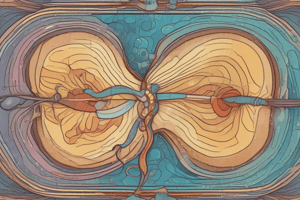Podcast
Questions and Answers
Which of the following age groups has the highest prevalence of benign prostatic hyperplasia (BPH)?
Which of the following age groups has the highest prevalence of benign prostatic hyperplasia (BPH)?
- Men over 80 years old
- Men between 50 and 60 years old
- Men over 70 years old (correct)
- Men around 40-45 years old
What is the primary role of the fluid secreted by the prostate gland?
What is the primary role of the fluid secreted by the prostate gland?
- To enhance sperm motility and reduce acidity (correct)
- To neutralize the pH of urine
- To provide nourishment for sperm cells
- To protect sperm from female antibodies
Where does hyperplasia primarily occur in the prostate gland in individuals with BPH?
Where does hyperplasia primarily occur in the prostate gland in individuals with BPH?
- Throughout the entire prostate gland
- In the transition zone of the prostate
- In the peripheral zone of the prostate
- In the periurethral region (surrounding the urethra) (correct)
Which of the sex steroid hormones, after conversion from testosterone, may accumulate in the prostate and promote overproliferation of prostatic cells?
Which of the sex steroid hormones, after conversion from testosterone, may accumulate in the prostate and promote overproliferation of prostatic cells?
What changes in hormone levels are believed to contribute to the development of benign prostatic hyperplasia (BPH)?
What changes in hormone levels are believed to contribute to the development of benign prostatic hyperplasia (BPH)?
What is the primary cause of the manifestations associated with benign prostatic hyperplasia (BPH)?
What is the primary cause of the manifestations associated with benign prostatic hyperplasia (BPH)?
Which of the following is a potential long-term complication of untreated benign prostatic hyperplasia (BPH)?
Which of the following is a potential long-term complication of untreated benign prostatic hyperplasia (BPH)?
What finding during a digital rectal exam would suggest malignancy of Prostate, rather than benign prostatic hyperplasia?
What finding during a digital rectal exam would suggest malignancy of Prostate, rather than benign prostatic hyperplasia?
Why is prostate-specific antigen (PSA) level measured in the diagnostic workup of benign prostatic hyperplasia (BPH)?
Why is prostate-specific antigen (PSA) level measured in the diagnostic workup of benign prostatic hyperplasia (BPH)?
After the elevation of prostate-specific antigen(PSA), which test can rule out malignancy?
After the elevation of prostate-specific antigen(PSA), which test can rule out malignancy?
What is the primary mechanism of action of smooth muscle relaxants used in the pharmacologic treatment of benign prostatic hyperplasia (BPH)?
What is the primary mechanism of action of smooth muscle relaxants used in the pharmacologic treatment of benign prostatic hyperplasia (BPH)?
What is the rationale behind inhibiting the conversion of testosterone to dihydrotestosterone (DHT) in the treatment of benign prostatic hyperplasia (BPH)?
What is the rationale behind inhibiting the conversion of testosterone to dihydrotestosterone (DHT) in the treatment of benign prostatic hyperplasia (BPH)?
A patient with BPH has a stent placed in his urethra. Which of the following side effects is he most likely to experience?
A patient with BPH has a stent placed in his urethra. Which of the following side effects is he most likely to experience?
Flashcards
Urinary frequency
Urinary frequency
The need to urinate more often than usual, common in BPH.
Hesitancy
Hesitancy
Difficulty starting urination, leading to delayed flow.
Hydroureter
Hydroureter
Dilation of the ureter due to urine build-up from obstructions.
Hydronephrosis
Hydronephrosis
Signup and view all the flashcards
Prostate-specific antigen (PSA)
Prostate-specific antigen (PSA)
Signup and view all the flashcards
TURP
TURP
Signup and view all the flashcards
Dihydrotestosterone (DHT)
Dihydrotestosterone (DHT)
Signup and view all the flashcards
Urodynamic testing
Urodynamic testing
Signup and view all the flashcards
Benign Prostatic Hyperplasia (BPH)
Benign Prostatic Hyperplasia (BPH)
Signup and view all the flashcards
Main risk factor for BPH
Main risk factor for BPH
Signup and view all the flashcards
Hormonal changes in BPH
Hormonal changes in BPH
Signup and view all the flashcards
Hyperplasia location in BPH
Hyperplasia location in BPH
Signup and view all the flashcards
Study Notes
Benign Prostatic Hyperplasia (BPH)
- BPH is a condition of aging, affecting nearly all men over 50.
- Aging is the largest risk factor, with more than 50% of men over age 60 and as many as 90% over age 70 experiencing some degree of prostate enlargement.
- The prostate is pea-sized at birth, growing until puberty, then rapidly until the 30s, reaching adult size.
- Prostate growth continues slowly from ~40-45 through old age to death.
- The prostate's main role is secreting fluid for semen.
BPH Pathophysiology
- Cause of BPH is unknown.
- Reduced testosterone levels in aging result in increased estrogen levels.
- Estrogen promotes prostatic cell proliferation (growth.)
- Testosterone converts to dihydrotestosterone (DHT), also involved in prostate growth, and may accumulate, promoting overproliferation.
- Hyperplasia primarily affects the periurethral part of the prostate.
- BPH is not considered a precursor to prostate cancer.
BPH Clinical Manifestations
- Manifestations relate to urethral obstruction.
- Common symptoms include: urinary frequency, hesitancy (difficulty starting urination), decreased force, urgency, prolonged urine retention, and overflow incontinence (uncontrolled leaks of urine).
- Significant reduction in urinary stream force.
- Complications may include hydroureter (swelling of the ureter), hydronephrosis (swelling of kidney), pyelonephritis (kidney infection), renal insufficiency, severe pain, and renal failure, leading to death.
BPH Diagnostic Criteria
- Diagnosing BPH involves reviewing patient medical history and conducting a physical exam.
- Digital rectal exams to assess prostate size, shape, and consistency (i.e. smooth/soft vs. hard/irregular like cobblestones.)
- Prostate-specific antigen (PSA) testing. Elevated PSA may indicate hyperplasia or dysplasia and often requires follow-up biopsy to rule out cancer.
- Urodynamic testing to measure urine volume and pressure in the bladder is used to assess urinary flow rate.
BPH Treatment
- Treatment is reserved for those experiencing significant symptoms.
- Pharmacologic treatments include smooth muscle relaxants to improve urine flow and drugs that inhibit testosterone conversion to dihydrotestosterone (DHT), which can potentially shrink the prostate.
- Laser or heat-based treatments can destroy all or part of the prostate.
- Surgical treatments include Transurethral Resection of the Prostate (TURP) to partially or fully remove the prostate tissue through the urethra, and stenting the urethra to keep it open for better draining.
Studying That Suits You
Use AI to generate personalized quizzes and flashcards to suit your learning preferences.




